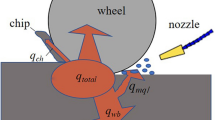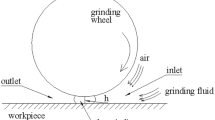Abstract
Due to the characteristics of the grinding process, thermal damage may occur in the workpiece surface, resulting in the rejection of a component and considerably increasing the production costs. This study aims to analyze the heat fluxes, energy partition, and temperatures during surface grinding process with both conventional and MQL lubrication. Through the proposed analysis, the heat fluxes and maximum temperature can be predicted, enabling the avoidance of thermal damages and increasing the efficiency of the process. A comparison between the calculated and experimental value has shown that the difference is acceptable for various situations, in the order of 4.72% for the conventional method and 7.38% for the MQL method. A thermal model was developed. The transient two-dimensional heat diffusion equation was discretized by finite volume method in space and explicit discretized in time. The heat fluxes were estimated using inverse problem technique of heat transfer aiming the obtainment of the temperature of certain workpiece points. A comparison of the methods of lubrication showed that the conventional method was way more efficient than MQL, presenting considerably lower total heat flux and maximum reached temperature and any kind of thermal damage wasn’t observed. On the other hand, thermal damage occurred in the workpieces. Also, clogging phenomenon in the grinding wheel surface after the process in MQL condition was observed.
















Similar content being viewed by others
References
Wegener K, Bleicher F, Krajnik P, Hoffmeister H, Brecher C (2017) Recent developments in grinding machines. CIRP Ann Manuf Technol 66:779–802
Lavisse B, Lefebvre A, Torrance AA, Sinot O, Henrion E, Lemarié S, Tidu A (2018) The effects of the flow rate and speed of lubricoolant jets on heat transfer in the contact zone when grinding a nitrided steel. J Manuf Process 35:233–243
Foeckerer T, Zaeh MF, Zhang OB (2013) A three-dimensional analytical model to predict the thermo-metallurgical effects within the surface layer during grinding and grind-hardening. Int J Heat Mass Transf 56:223–237
Li B, Li C, Zhang Y, Wang Y, Jia D, Yang M, Zhang N, Wu Q, Han Z, Sun K (2017) Heat transfer performance of MQL grinding with different nanofluids for Ni-based alloys using vegetable oil. J Clean Prod 154:1–11
Gupta A, Swami P, Balan ASS, Kuppan P, Oyyaravelu R (2018) Numerical modeling and heat transfer analysis of minimum quantity lubrication grinding of Inconel 751. Mater Today 5:13358–13366
Colaço MJ, Orlande HRB, Dulikravich GS (2006) Inverse and optimization problems in heat transfer. J Braz Soc Mech Sci Eng 28:1–24
Hadad M, Sadeghi B (2012) Thermal analysis of minimum quantity lubrification - MQL grinding process. Int J Mach Tool Manu 63:1–15
Parente MPL, Jorge RMN, Vieira AA, Baptista AM (2012) Experimental and numerical study of the temperature field during creep grinding. Int J Adv Manuf Technol 61:127–134
Zhan YJ, Xu PX (2012) An experimental investigation of temperatures and energy partition in grinding of cemented carbide with a brazed diamond Wheel. Int J Adv Manuf Techonol 61:117–125
Brosse A, Naisson P, Hamdi H, Bergheau JM (2008) Temperature measurement and shear flux characterization in grinding using thermography. J Mater Process Technol 201:590–595
Kim H, Kim N, Kwak J (2006) Heat flux distribuition model by sequential algorithm of inverse heat transfer for determining workpiece temperature in creep feed grinding. Int J Mach Tool Manu 46:2086–2093
Carvalho RN, Orlande HRB, Colaço MJ (2012) A comparison of the iterative technique and the Kalman filter for the estimation of boundary in grinding. Eng Opt
González JL (2016) Maximum temperature in dry surface grinding for high peclet number and arbitrary heat flux profile. Math Probl Eng 2016:1–9
Rowe WB (2001) Thermal analysis of high efficiency deep grinding. Int J Mach Tool Manu 41:1–19
Dogra M, Sharma VS, Dureja JS, Gill SS (2018) Environment-friendly technological advancements to enhance the sustainability in surface grinding- A review. J Clean Prod 197:218–231
Brosse A, Naisson P, Hamdi H, Bergheau JM (2008) Temperature measurement and heat flux characterization in grinding using thermography. J Mater Process Technol 201:590–595
Marinescu ID (2004) Tribology of Abrasive Machining Process. William Andrew Publishing, New York
Yin G, Marinescu I (2017) A heat transfer model of grinding process based on energy partition analysis and grinding fluid cooling application. J Manuf Sci Eng 139:1–11
Rowe WB (2014) Principles of modern grinding technology. Elsevier, New York
Malkin S (1989) Grinding Technology: Theory and Applications of Machining With Abrasives. Society of Manufacturing Engineers, Dearborn
Rowe WB, Morgan MN, Batako A, Jin T (2003) Heat flux distributions and convective heat transfer in deep grinding. Int J Mach Tool Manu 44:1743–3533
Zhu D, Li B, Ding H (2013) An improved grinding temperature model considering grain geometry and distribution. Int J Adv Manuf Technol 67:1393–1406
Rodriguez RL, Lopes JC, Mancini SD, Sanchez LEA, Varasquim FMFA, Volpato RS et al (2019) Contribution for minimization the usage of cutting fluids in CFRP grinding. Int J Adv Manuf Technol:1–11
Bianchi EC, Rodriguez RL, Hildebrandt RA, Lopes JC, Mello HJ, Aguiar PR et al (2019) Application of the auxiliary wheel cleaning jet in the plunge cylindrical grinding with minimum quantity lubrication technique under various flow rates. Proc Inst Mech Eng B J Eng Manuf 233:1144–1156
Lopes JC, Ventura CE, Fernandes LDM, Tavares AB, Sanchez LE, Mello HJ et al (2019) Application of a wheel cleaning system during grinding of alumina with minimum quantity lubrication. Int J Adv Manuf Technol 102:333–341
Fernandes LDM, Lopes JC, Volpato RS, Diniz AE, Oliveira RFM, Aguiar PR et al (2018) Comparative analysis of two CBN grinding wheels performance in nodular cast iron plunge grinding. Int J Adv Manuf Technol 98:237–249
Morgan MN, Rowe WB, Black SCE, Allanson DR (1998) Effective thermal properties of grinding wheels and grains. Proc Inst Mech Eng B 212:661–669
Incropera F, DeWitt D, Bergman TL, Lavine A (2011) Fundamentals of heat and mass transfer, 7th edn. Wiley
Guo C, Ranganath S, McIntosh D, Elfizy A (2008) Virtual high performance grinding with CBN wheels. CIRP Ann Manuf Technol 57:325–328
Gopan V, Wins KLD (2016) Quantitative analysis of grinding wheel loading using image processing. Proc Technol 25:885–891
Morgan MN, Jackson AR, Wu H, Baines-Jones V, Batako A, Rowe WB (2008) Optimisation of fluid application in grinding. CIRP Ann Manuf Technol 57:363–366
Tawakoli T, Hadad MJ, Sadeghi MH, Daneshi A, Stöckert S, Rasifard A (2009) An experimental investigation of the effects of workpiece and grinding parameters on minimum quantity lubrication—MQL grinding. Int J Mach Tool Manu 49:924–932
Sadeghi MH, Hadad MJ, Tawakoli T, Vesali A, Emami M (2010) An investigation on surface grinding of AISI 4140 hardened steel using minimum quantity lubrication-MQL technique. Int J Mater Form 3:241–251
Bianchi EC, Rodriguez RL, Hildebrandt RA, Lopes JC, Mello HJ, Silva RB, Aguiar PR (2018) Plunge cylindrical grinding with the minimum quantity lubrication coolant technique assisted with wheel cleaning system. Int J Adv Manuf Technol 95:2907–2916
Yuan Z, Zhu B, Lu Z, Zhang F (2001) Finish surface grinding of titanium alloys. Initiatives of Precision Engineering at the Beginning of a Millennium:481–485
Acknowledgements
The authors thank ITW Chemical Products, Quimatic Tapmatic, and Norton Co–Saint-Gobain group for the donation of cutting fluids and grinding wheel, the support to the research, and opportunity for scientific and technological development.
Funding
This study received financial support from São Paulo Research Foundation (FAPESP—process 2015/10460-4) and the Coordination for the Improvement of Higher Level Education Personnel (CAPES).
Author information
Authors and Affiliations
Corresponding author
Additional information
Publisher’s note
Springer Nature remains neutral with regard to jurisdictional claims in published maps and institutional affiliations.
Rights and permissions
About this article
Cite this article
de Martini Fernandes, L., Lopes, J.C., Ribeiro, F.S.F. et al. Thermal model for surface grinding application. Int J Adv Manuf Technol 104, 2783–2793 (2019). https://doi.org/10.1007/s00170-019-04101-6
Received:
Accepted:
Published:
Issue Date:
DOI: https://doi.org/10.1007/s00170-019-04101-6




